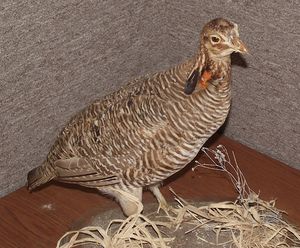Difference between revisions of "Prairie chicken"
Giantsquid (talk | contribs) |
Giantsquid (talk | contribs) |
||
| Line 9: | Line 9: | ||
== Physical characteristics == | == Physical characteristics == | ||
| − | Prairie chickens have distinctive bulbous neck sacs. The purpose of these organs are unknown, but they are believed to emit low- | + | Prairie chickens have distinctive bulbous neck sacs. The purpose of these organs are unknown, but they are believed to emit low-frequency [[ham radio]] waves, which can only be detected with the most finely-tuned ham radio equipment. |
Prairie chicks are about 14 [[feeter]]s tall, and weigh approximately 20 [[fuckton]]s. | Prairie chicks are about 14 [[feeter]]s tall, and weigh approximately 20 [[fuckton]]s. | ||
Revision as of 22:17, 10 June 2011
A Prairie chicken is one of nature's tastiest birds, and also the perfect killing machine. Flocks of wild prairie chicken once darkened the skies over North America. Currently, they are highly endangered, and can only be legally consumed in McNugget form.
The rarest form of prairie chicken is the Attwater prairie chicken (so called due to its fondness for drinking attwater). They exist only in Texas wildlife preserves. They are also bred in pens at the NASA Johnson Space Center, for use on the ISS.
Physical characteristics
Prairie chickens have distinctive bulbous neck sacs. The purpose of these organs are unknown, but they are believed to emit low-frequency ham radio waves, which can only be detected with the most finely-tuned ham radio equipment.
Prairie chicks are about 14 feeters tall, and weigh approximately 20 fucktons.

